The 2030 Agenda was developed to reflect that “the international community has made significant strides towards lifting people out of poverty (…). However, inequality still persists and large disparities remain in access to health and education services and other assets”. 1
Although the number of people living with less than $1.25 per day has declined by more than half – from 1.8 billion in 1999 to 836 million in 2015 – greater inequality has been reported in both developed and developing countries, as well as between countries. 2 Inequality is rooted in a broad range of factors, including environmental degradation, poverty, persistent unemployment, conflict, violence and political instability, but also in other structural aspects such as poor representation, discrimination and lack of sufficient wage, social and fiscal policies.
Hence, the Sustainable Development Goal 10 (SDG 10) addresses inequality from a broad perspective to reduce disparities within and between countries. Its 10 targets and 11 indicators consider social, institutional and economic factors to ensure inclusive growth, equal representation and opportunities. 3
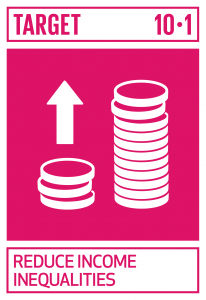 | 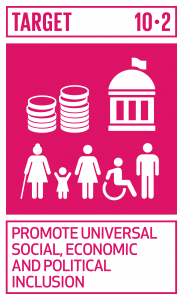 | 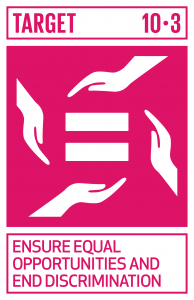 | 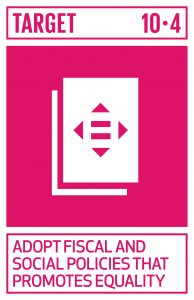 | 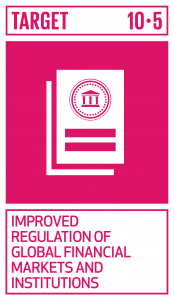 |
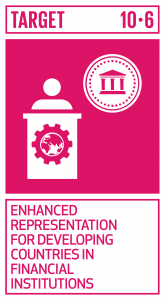 | 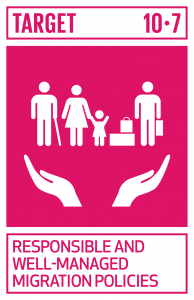 | 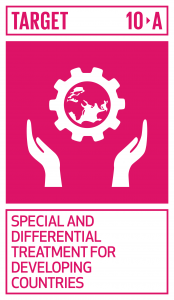 | 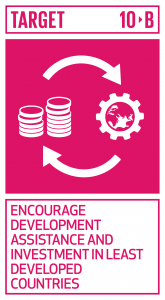 | 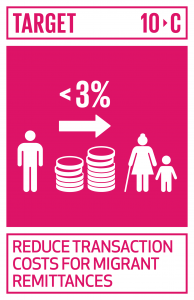 |
Transition from the MDG to SDG 10
Given the growing consensus on the idea that inequality hinders sustainable development, the absence of a goal solely addressing such inequalities was a major criticism to the Millennium Development Goals (MDGs). A number of shortcomings identified in the final assessment of the MDGs highlighted the persistence of inequality and the uneven distribution of the benefits arising from economic growth. 4
- Persistence of gender inequality, with women facing discrimination in access to work, economic assets and participation in private and public decision-making. Women are more likely to live in poverty than men and remain at a disadvantage in the labor market.
- Gaps between the poorest and richest households. In developing countries, children from poorer household are significantly more likely to be out of school, suffer from undernutrition and face much higher under-five mortality rates.
- Gaps between rural and urban areas. Around 50% of people in rural regions lack improved sanitation facilities, compared to the 18% in urban areas. The number of births attended by skilled health practitioners is 56% and 87% for rural and urban regions respectively.
- Poor people suffer the most from climate change and environmental degradation.
- The MDGs brought substantial improvements but the uneven distribution of economic growth and development lead to the persistence and widening of inequalities across the world.
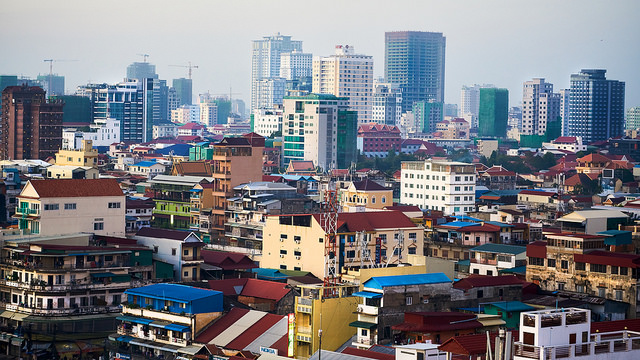
Photo of Phnom Penh City. Photo by Bryon Lippincott, taken on 07 January 2018. License under CC BY-ND 2.0
As in the case of the Global MDGs, the issue of inequality was only mentioned in a few Cambodian Millennium Development Goals (CMDGs). CMDG 1 included an indicator (1C) seeking to “raise the share of income received by the poorest 20% to 11% of total income”. CMDG 2 (2D) addressed education inequalities and sought gender parity at primary school level. CMDG 3 (3A, 3B and 3C) focused on gender disparities at social, political and economic spheres and aimed at achieving gender equality in education and literacy, wage employment and decision-making processes. The final performance assessment of these targets was as follows: 1C unfinished; 2D achieved; 3A achieved; 3B unfinished; 3C unfinished. In addition, MDG 8 aimed at “developing a Global Partnership for Development” stressing the role that Official Development Assistance (ODA) plays in reducing inequalities between countries but Cambodia did not set any targets for the latter. 5
The Royal Government of Cambodia (RGC) is well aware of the persisting regional inequalities in the country in terms of income, health, education, and gender, among others. The significant differences in living standards and employment opportunities further exacerbate such divergences between social groups and enlarge the rural-urban divide. In fact, this was a crucial challenge for the implementation of the CMDGs. 6
therefore, the international community called for joint action to promote a more even distribution of growth and its benefits. The 2030 Agenda brings inequality at the forefront of the global development strategy, by emphasizing that inequality is a global and cross-sector issue, and integrating detailed measures to mitigate the growing economic divergences CMDGs. 7
A measure to reduce national inequalities is to ensure that income growth among the poorest 40% of the population in each country is more rapid than its national average. To tackle the growing disparities between countries, there will be more preferential trade treatments for developing countries and least developed countries (LDCs) to enhance their exports and improve their trade balances. Despite an increase in duty-free treatments between 2000 and 2014, which accounted for 79% and 84% of exports for developing and LDCs respectively – the comparative advantage of these countries needs further improvement. The Goal encourages official development assistance and financial flows to States where the need is greatest. Moreover, given the magnitude of migration movements, particularly in developing countries, the Goal calls to reduce to less than 3% the transaction costs of migrant remittances. 8
The localization of SDG 10 in Cambodia
Cambodia is one of the fastest growing countries in the world, with sustained and robust average annual growth rates ranging between 7 and 8%. However, widespread inequalities require greater inclusive growth, as it is underlined in the national frameworks, including the National Strategy Development Plan (NSDP) 2014-2018 and the Rectangular Strategy.
The process to adapt the global framework to fit Cambodia’s context started in late 2015, shortly after the Global Goals were adopted at the UN General Assembly. Despite endorsing the Global Goals along with the UN Assembly in September 2015, Cambodia did not approve the localized Cambodian Sustainable Development Goals (CSDGs) until November 2018.
The localization of SDG 10 was, along the other SDGs, carried out through a participatory and consultative process led by the Ministry of Planning (MoP) with the collaboration of UN agencies, Line Ministries (LMs) and Ministerial Technical Working Groups (TWGs) and a number of Civil Society Organizations (CSOs). Thorough analyses were crucial in the preparation process, namely a Rapid Integrated Assessment (RIA) which mapped SDGs and national priorities and a United Nations Statistics Division (UNSD) assessment of indicators and data sources.
The Mid-term review of the NSDP 2014-2018 assessed the degree of alignment between the CSDGs and the national framework. The review mentioned that the CSDG 10 is:
- Directly complementary to only one of the priorities – that of poverty reduction and inclusive growth.
- Partially complementary to expanding agriculture; managing migration and urbanization; better governance; improving the human resource base.
Given the comprehensive and ambitious approach of the UN Agenda – and in turn of the CSDGs – the RGC has stressed the need to prioritize and define rolling-out phases for the goals. The RGC, via national planning processes and the proposed consultations structure, will seek to identify key targets and further specify the order in which they should be addressed, guided by the principle of “leaving no one behind”. 9
Out of the 10 targets of the Global SDG 10, only five were determined to be relevant to the Cambodian context and incorporated into CSDG 10. These targets are to be monitored by one indicator each, accounting for 5 total indicators for the CSDGs (see Figure 3).
Means of implementation for SDG 10 in Cambodia
The CSDGs require a sound forecasting of financial and other resources. According to projections from the Development Finance Assessment (DFA) by the Council for the Development of Cambodia (CDC) in 2017, despite improved fiscal and economic performance, the country faces significant challenges and will need to direct its efforts to meet its needs. 10
Since Cambodia has officially become a Lower Middle Income Country (LMIC), its funding and financial scenario is substantially changing. As the country keeps growing, Cambodia will eventually not qualify for certain types of aid and funds, and donors will start to shift their focus to countries with other needs. Hence, there are significant changes to funding strategies in the post 2015 Agenda; resources primarily need to be generated internally and Cambodia needs to rely less on external aid. Despite improvements in the government’s capacity to generate its own resources (18% of the GDP), Cambodia still heavily relies on other financial flows. Some, such as NGO funding and ODA, will most likely decline in the upcoming years.
Line Ministries (LMs) and Line Agencies (LAs) are responsible for the first two targets of the CSDG 10: those related to reducing economic, social and political inequality among Cambodians. The Ministry of Social Affairs, Veterans and Youth Rehabilitation (MoSVY) coordinates the third target as it will track the record of civil servants retirees and disabled people. The fourth target, focusing on international agreements, will be coordinated by the Ministry of Commerce. Finally, the Cambodian Rehabilitation and Development Board (CRDB) and the Council for the Development of Cambodia (CDC) are responsible for the fifth target, which has to do with ODA. 11
The responsible Ministries and Agencies will closely work with a number of other governmental bodies, NGOs and private sector stakeholders in both the implementation and the compilation of data and performance tracking.
Monitoring and Evaluation of SDG 10 in Cambodia
The MoP is the monitoring and evaluation coordinator of the SDGs and holds ownership of the central database in which the performance of the CSDGs indicators will be tracked. The MoP will be responsible for centralizing the data for the different Goals and targets and compiling it into annual and five yearly reports.
Monitoring such a comprehensive Agenda however, requires strong collaboration to coordinate input gathering from all stakeholders involved. All relevant stakeholders will be trained under the National Strategy for Development of Statistics (NSDS) to enhance regular and homogenized inputs. 12
Data for the five indicators being monitored will be gathered yearly and will be assessed against the CSDG Framework. 13
Targets, Indicators and objectives for the CSDG 10.
| CSDG Targets | CSDG Indicators | Unit | Baseline (2015) | 2020 | 2025 | 2030 |
| 10.1 By 2030, progressively achieve and sustain income growth of the bottom 40 per cent of the population at a rate higher than the national average | 10.1.1 Growth rates of household expenditure or income per capita among the bottom 40 per cent of the population and the total population | % | 5.20 (2016) | 9.20 | 14.20 | 19.20 |
| 10.2 By 2030, empower and promote the social, economic and political inclusion of all, irrespective of age, sex, disability, race, ethnicity, origin, religion or economic or other status | 10.2.1 Proportion of people living below 50 per cent of median income, by age, sex and persons with disabilities | % | 53.10 | 45.40 | 37.70 | 30.00 |
| 10.4 Adopt policies, especially fiscal, wage and social protection policies, and progressively achieve greater equality | 10.4.1 Civil servants retirees and invalid | Number | 52,274 (2016) | 58,762 | 64,902 | 70,742 |
| 10.A Implement the principle of special and differential treatment for developing countries, in particular least developed countries, in accordance with World Trade Organization agreements | 10.a.1 Numbers of International Agreements | Number | 20 | 23 | 27 | 31 |
| 10.B Encourage official development assistance and financial flows, including foreign direct investment, to States where the need is greatest, in particular least developed countries, African countries, small island developing States and landlocked developing countries, in accordance with their national plans and programmes | 10.b.1 Total official development assistance for Cambodia | Million USD | 1,425 (2016) | 1,425 | 1,425 | 1,425 |
Related Topics
References
- 1. SDG Tracker. “Sustainable Development Goal 10”. Accessed 11 March 2019
- 2. United Nations Development Programme, 2015. “Eradicate extreme poverty and hunger. Where do we stand?”. Accessed 11 March 2019
- 3. The Global Goals. “Resources”. Accessed 18 March 2019
- 4. United Nations, 2015. “The Millennium Development Goals Report 2015”. Accessed 18 March 2019
- 5. Royal Government of Cambodia 2018. “Cambodian Sustainable Development Goals (CSDGs) Framework (2016-2030)”. Accessed 13 March 2019
- 6. Royal Government of Cambodia. “Cambodia Millennium Development Goals Report 2003”. Accessed 13 March 2019
- 7. Economic and Social Council of the United Nations, 2018. “Progress towards the Sustainable Development Goals”. Accessed 13 March 2019
- 8. Ibid
- 9. Royal Government of Cambodia 2018. “Cambodian Sustainable Development Goals (CSDGs) Framework (2016-2030)”. Accessed 13 March 2019
- 10. Ibid
- 11. Ibid
- 12. Ibid
- 13. Ibid

